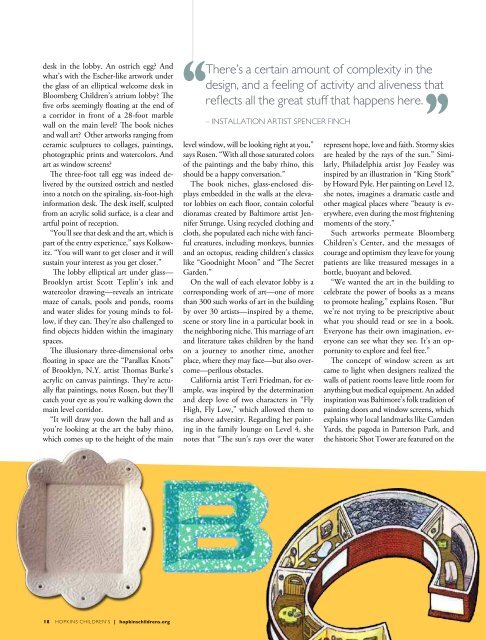Meals “at Your request” - Johns Hopkins Children's Center
Meals “at Your request” - Johns Hopkins Children's Center
Meals “at Your request” - Johns Hopkins Children's Center
Create successful ePaper yourself
Turn your PDF publications into a flip-book with our unique Google optimized e-Paper software.
desk in the lobby. An ostrich egg? And<br />
what’s with the Escher-like artwork under<br />
the glass of an elliptical welcome desk in<br />
Bloomberg Children’s atrium lobby? The<br />
five orbs seemingly floating at the end of<br />
a corridor in front of a 28-foot marble<br />
wall on the main level? The book niches<br />
and wall art? Other artworks ranging from<br />
ceramic sculptures to collages, paintings,<br />
photographic prints and watercolors. And<br />
art as window screens?<br />
The three-foot tall egg was indeed delivered<br />
by the outsized ostrich and nestled<br />
into a notch on the spiraling, six-foot-high<br />
information desk. The desk itself, sculpted<br />
from an acrylic solid surface, is a clear and<br />
artful point of reception.<br />
“You’ll see that desk and the art, which is<br />
part of the entry experience,” says Kolkowitz.<br />
“You will want to get closer and it will<br />
sustain your interest as you get closer.”<br />
The lobby elliptical art under glass—<br />
Brooklyn artist Scott Teplin’s ink and<br />
watercolor drawing—reveals an intricate<br />
maze of canals, pools and ponds, rooms<br />
and water slides for young minds to follow,<br />
if they can. They’re also challenged to<br />
find objects hidden within the imaginary<br />
spaces.<br />
The illusionary three-dimensional orbs<br />
floating in space are the “Parallax Knots”<br />
of Brooklyn, N.Y. artist Thomas Burke’s<br />
acrylic on canvas paintings. They’re actually<br />
flat paintings, notes Rosen, but they’ll<br />
catch your eye as you’re walking down the<br />
main level corridor.<br />
“It will draw you down the hall and as<br />
you’re looking at the art the baby rhino,<br />
which comes up to the height of the main<br />
18 HOPKINS CHILDreN’S | hopkinschildrens.org<br />
There’s a certain amount of complexity in the<br />
design, and a feeling of activity and aliveness that<br />
reflects all the great stuff that happens here.<br />
– INSTALLATION ArTIST SPeNCer FINCH<br />
level window, will be looking right at you,”<br />
says Rosen. “With all those saturated colors<br />
of the paintings and the baby rhino, this<br />
should be a happy conversation.”<br />
The book niches, glass-enclosed displays<br />
embedded in the walls at the elevator<br />
lobbies on each floor, contain colorful<br />
dioramas created by Baltimore artist Jennifer<br />
Strunge. Using recycled clothing and<br />
cloth, she populated each niche with fanciful<br />
creatures, including monkeys, bunnies<br />
and an octopus, reading children’s classics<br />
like “Goodnight Moon” and “The Secret<br />
Garden.”<br />
On the wall of each elevator lobby is a<br />
corresponding work of art—one of more<br />
than 300 such works of art in the building<br />
by over 30 artists—inspired by a theme,<br />
scene or story line in a particular book in<br />
the neighboring niche. This marriage of art<br />
and literature takes children by the hand<br />
on a journey to another time, another<br />
place, where they may face—but also overcome—perilous<br />
obstacles.<br />
California artist Terri Friedman, for example,<br />
was inspired by the determination<br />
and deep love of two characters in “Fly<br />
High, Fly Low,” which allowed them to<br />
rise above adversity. Regarding her painting<br />
in the family lounge on Level 4, she<br />
notes that “The sun’s rays over the water<br />
represent hope, love and faith. Stormy skies<br />
are healed by the rays of the sun.” Similarly,<br />
Philadelphia artist Joy Feasley was<br />
inspired by an illustration in “King Stork”<br />
by Howard Pyle. Her painting on Level 12,<br />
she notes, imagines a dramatic castle and<br />
other magical places where “beauty is everywhere,<br />
even during the most frightening<br />
moments of the story.”<br />
Such artworks permeate Bloomberg<br />
Children’s <strong>Center</strong>, and the messages of<br />
courage and optimism they leave for young<br />
patients are like treasured messages in a<br />
bottle, buoyant and beloved.<br />
“We wanted the art in the building to<br />
celebrate the power of books as a means<br />
to promote healing,” explains Rosen. “But<br />
we’re not trying to be prescriptive about<br />
what you should read or see in a book.<br />
Everyone has their own imagination, everyone<br />
can see what they see. It’s an opportunity<br />
to explore and feel free.”<br />
The concept of window screen as art<br />
came to light when designers realized the<br />
walls of patient rooms leave little room for<br />
anything but medical equipment. An added<br />
inspiration was Baltimore’s folk tradition of<br />
painting doors and window screens, which<br />
explains why local landmarks like Camden<br />
Yards, the pagoda in Patterson Park, and<br />
the historic Shot Tower are featured on the





